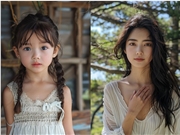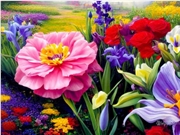Website Administrator's Home (ChinaZ.com) May 30th News: Recently, I came across a very creative AI project on Twitter. Using artificial intelligence technology, it combines children's photos with the styles of over ten historical great painters to create a personalized children's book.
The significance of this album lies in bringing children closer to artists, placing them within the masterpieces of famous painters. It is an excellent tool for educating children about historical renowned painters.

Website Address: https://selfarama.com/books/my-book-of-art-history
As you can see, the price for generating a physical book on this foreign website is quite high, with a paperback selling for $39, roughly over 300 RMB. The hardcover version is priced at $49, nearly 400 RMB.
The interior page effect is like this:

It looks quite good. If such books had a more affordable price, I believe many parents would buy them.
I suddenly have a bold idea. We can use AI to create such interior pages and then have them printed on Taobao, which would significantly reduce costs. I roughly searched and found that printing an album on Taobao costs between ten to twenty RMB. If we offer this service to other parents at a fair price, say 268 RMB per book, we can earn a hard-earned income.
So, how do we create the interior page images? Here is the detailed tutorial:
Creating such a physical painting mainly involves three steps:
Blend children's photos with painter styles
Layout the generated photos into an album
Print the finished product
1. Blend children's photos with painter styles
There are two methods to blend children's photos with certain painter styles:
1. Use mj, by using --sref to reference two images for blending
Here, I'll use "The Girl Wearing Pearl Earrings" as an example
Prompt example: Johannes Vermeer's painting "The Girl Wearing Pearl Earrings", oil painting --sref (painter's masterpiece) --cref (child's photo) --cw0 --ar3:4 --niji6

2. Use coze image flow
We previously shared a tutorial on giving Musk a white cat portrait effect using coze image flow. For those who are unclear, you can click here to access: https://www.chinaz.com/2024/0522/1618264.shtml
The steps to create an image flow will not be repeated here.
For this famous painting-style portrait, coze has a ready-made image flow template that can be used. The example they used is also "The Girl Wearing Pearl Earrings".
We directly select this famous painting portrait template in the explore image flow section and create a copy.

Then, we enter the workflow page, where we can see that this is already a complete workflow. So, we don't need to change anything to create the first album picture; we can use it directly.

Click the "Try Run" in the upper right corner and directly upload the child's photo you want to blend. After the run is complete, save the picture.

So, how do we create other pictures? It's simple; just slightly modify the original workflow.
The first step remains unchanged, with the input variable being the photo the user wants to upload.

Then, to make it closer to the original painter's style, simply blending the original image is not enough. So, I added a step, text-to-image. The first and fourth items are the image's width and height, which you can set yourself; I won't explain too much here. The third item is the ratio.
The aspect ratio of the generated image is represented by the following numbers:
1 (1:1), 2 (4:3), 3 (16:9), 4 (3:4), 5 (9:16)
The second item is the prompt for text-to-image. For example, if I'm doing Van Gogh's self-portrait, the prompt is set as follows:
a little girl, solo, Van Gogh's self-portrait style, oil painting

Then, link this step to the original blending step, and the rest can remain unchanged.

The complete process is as follows:

After the complete workflow is done, click "Try Run".

Here is the output image effect. After you are satisfied, save the picture. If you want to use this for a project and reuse it in the long term, remember to publish it, so you can keep this template for repeated use.

2. Photo Layout
This step is simple. You can use your preferred tools, such as PS or Canva, to layout the text and images.
Here, I directly use PS to create.

Note: Generally, printed albums have requirements for size and image quality. It's best to consult the seller in advance about the suitable size.
3. Printing
After the layout is complete, you can directly find a Taobao seller to print. If you have your own printer, you can also print it yourself. Albums generally use coated paper for a better effect.










